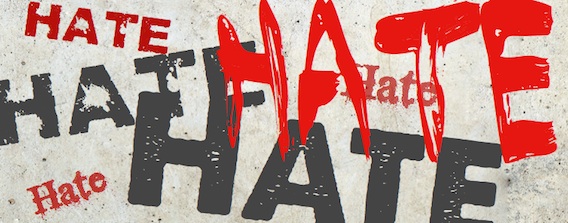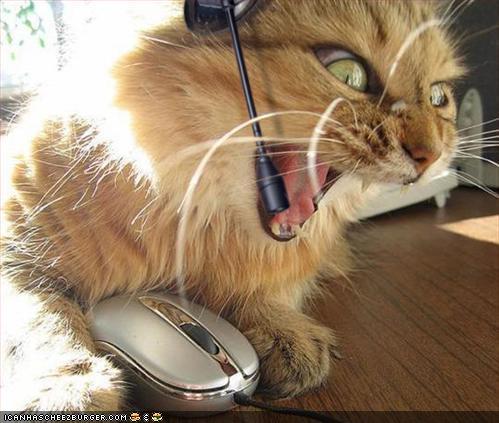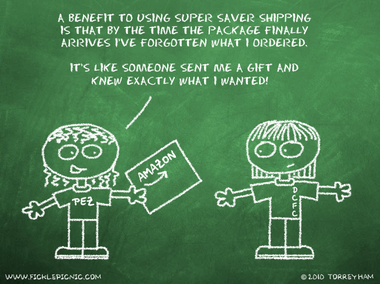-

Stop the Hate (Gamers)
In 2002 the world was introduced to Friendster, with MySpace soon to follow, but it was Facebook launching in 2004 and Twitter in 2006 that truly solidified the power of social media. These platforms have sparked millions of people to become more vocal of their ideals and opinions, and this in turn is shaping traditional business models and enforcing accountability for what people say in public. Sadly this social platform also has its negatives; an ugly side I wish the gaming community would do its best to change.
“We need to stop letting hate define us,” said Destructoid contributor Brett Makedonski not too long ago. We should stop berating EA, claiming they’re the worst company in America (again), and instead acknowledge the amazing IP’s the company has brought to the table. We should have toned down our anger over the Sim City debacle – if Diablo III’s Error 37 was any indication of how much the game would actually sell. Brett was inspired by a piece from Fall Out Boy’s lead singer Patrick Stump, who described the hate environment of pop culture. The same way mentioning Nickelback cues a barrage of insults, even uttering EA induces hisses and groans. Unfortunately this is just touching the surface of how the gaming community reacts to matters we don’t like, and it’s that strong reaction that paints gamers in a negative light and stops us from being seen as anything more than rabid children.
If there’s a pundit on Fox News claiming something as ridiculous as, “the increase in rapes can be attributed in large part to the playing out of [sexual] scenes in video games,” their products are sure to have hundreds of negative reviews within a few days. Make a public statement that video games are bad for our children? Threats are sure to be in your inbox by noon. Has a game developer you admire tweeted something that offended you? Then the solution is to constantly tweet them until they apologize, even if this means tweeting them days later after the incident. There are so many examples of how aggressive the community can be when we feel threatened, and this needs to end. Threats, review bombs, and harassment hinders intellectual discussion, and just becomes another reason people with a higher platform (generally Fox and government officials) become outspoken about the video game culture.
You’re proving them right.
Cooper Lawrence is known for her SE-XBOX Mass Effect Fox News debut in 2008, where she argued with Geoff Keighly on whether or not Mass Effect was a sex emulator that has the potential to influence the psyche of young boys. Soon after her appearance, she started receiving nasty e-mails and her newest book on Amazon is sitting at a pretty 178 1-star reviews. Carole Lieberman, the psychiatrist who made the rape statement above, received similar treatment in 2011, with 135 1-star reviews sitting on her last book Bad Girls: Why Men Love Them & How Good Girls Can Learn Their Secrets. Cooper Lawrence has since recanted what she said on public television, acknowledging that she was misinformed on the game itself and that she was coached before her on-air appearance (a tactic Fox News has used before). The 1-star reviews she received in retialation to her appearance were probably the triggerprompting her recant, but that just makes her apology all the less sincere. And all those reviews are still there years later, a prime example of how the gaming community reacts to negative press.
The same can be said for Carole Lieberman. She was approached for separate interviews to explain her statement, and she failed to deliver any proof to back-up her claims. However, what she did provide was examples of the type of harrassing e-mails you was receiving on a daily basis after the article went live:
“I played Bulletstorm demo, and like I felt I need to rape someone. So I went into this kind of deep trance, which caused me to rape 10, 15 years-old girl. [sic] What do I do now? The game made me do it. Please help me. By the way, you look like a fucking deadbeat pornstar. Yours truly, JohnnyMassiveHomoCunt OMG LOL my shift broke. P.S. Playing Mass Effect gave me a sudden need to shoot you in the head. Would you please come here so I can fulfill my needs?”
Dr. Lieberman made a comment that perfectly summed up my concern with these types of retaliations, “The irony is here are people trying to say video games don’t cause people to be violent, but the ones I’ve read are very violent. They’re out of control.”
I understand the passion to want to stop the spreading of misleading information, as it’s harmful to the medium and those who enjoy video games, especially when this erroneous data is presented on a platform like television with such a wide audience unfamiliar with our culture. However, these backlashes cause more harm than good, and it becomes more detrimental when we begin attacking our own people in the industry.
When Anita Sarkeesian started her Kickstarter campaign for “Tropes vs. Women in Video Games,” she never expected the type of reaction she encountered from her initiatives. Hateful remarks and threats littered the page. The other side of the industry that believed in her cause and wanted to send a message to those rallying against her backed up her campaign in full force, so much so that she earned over $150,000 more than she needed for her project. In the months that followed, before her first video was even uploaded, Sarkeesian continued to suffer from cyberbullying. She was attacked for being Jewish, any males who spoke up for her were labeled as gay, her social media accounts were subject to hack attempts, and her website was bombarded by DDOS attacks. She had to delete her gamertags and photos of her friends and family from the internet to protect herself. Even worse, a game was created to beat up a picture of her to a bloody pulp, the last ugly result of an unnecessary attack on someone’s character.
I comprehend some of the apprehension to Sarkeesian’s efforts. There are those who believe she is biased in her feminist approach to iluminating sexism in movies and television, as her previous videos have neglected to include information that would otherwise refute some of her claims. This is a logical objection. Then there’s those who are threatened by someone trying to enlighten the public on the sexism present in video games today, because it’s badmouthing a world gamers hold dear. But the harrassment Sarkeesian has been subjected to is by no means okay, and just serves as a reminder that we need to evaluate our knee-jerk reactions. With the first video in the series out titled “Damsels in Distress” Saarkesian actually disabled the comments and rating system on YouTube to prevent further harassment, which instead prevents further discussion on any points she brings up in the video, but is completely understandable when looking at what she’s had to go through. A Destructoid community member made a video of his own to illustrate how he believes Anita got some things wrong and thus painted a one-sided bias argument.
This is exactly how you should go about it. Discussion > hate speech.
Treading our way back to reviews, we have many instances of customer wrath as well. Mass Effect 3 was a subject in the news for months after the game released, and consumers made sure to let Bioware know how they felt about the game’s ending… on Metacritic, on their social media pages, even to their doorstep. Going back a few years, we also have Spore, the brainchild of Sim City‘s Will Wright. Standing as one of the most anticipated games of 2008, people were stunned to find DRM plaguing their game upon purchase. Players were outraged that they were required to be online to activate the game and were restricted to three installations max. Til this day Spore still has a jarring number of 1star Amazon reviews, something Sim City is now experiencing.
Finally, if this all wasn’t disheartening enough, we turn on ourselves. When a fellow gamer expresses personal stories in relation to video games, they are sharing because they hope to be embraced by like-minded individuals who will understand what he or she went through and how video games have helped them achieve a better understanding of themselves. What they don’t, and shouldn’t, expect is people’s disinterest and cruelty. Kotaku was nice enough to run a feature on a boy who suffered from depression who found strength in his childhood playing as Lara Croft. With the new Tomb Raider he felt even more at home, he grew alongside Lara in her struggles. It was a wonderful piece on overcoming personal obstacles through an interactive medium, and yet the comments literring the article were hateful. The comment that sticks with me the most, “And not a single f*** was given.”
Unbelievable.
Brendan Sinclair wrote an excellent piece on why we react the way we do, and I hope by embracing the true reasons behind our gut reactions, we can move forward to better address the issues we don’t like. It’s okay to be angry; we’re a passionate bunch. For those of us who read Joystiq on a daily basis and listen to GiantBomb podcasts, we love vidya games and will do our best to protect its integrity. But we also have to remember that it’s a double-edged sword: we can’t protect what we love by telling someone they should die and then expect them to show us some respect.
The world doesn’t work that way, and we sometimes forget the internet isn’t separate from reality.
Read More -

A Note on the IGDA Controversy
Another party, another controversy, this time at the Game Developer Conference. You can be sure if there’s an article denouncing a party or event of some sort, it usually involves women. The IGDA has come under fire after news broke out that their GDC party last night had a group of scantily clad women dancing for the patrons of the party. As a result, many developers have pulled their support from the organization and some have even stepped down as board members.
Here we have the two usual camps to the controversy: those who are outraged and those who are confused by said outrage. If we’re to set aside the percentage of the confused herd that are saying we’re too sensitive (you know who they are), we’re left with those that are honestly perplexed by the entire situation. As an industry, we sometimes forget that there are people that see nothing wrong with this type of entertainment and that it has nothing to do with sexism. They’re those who are not offended, in fact comfortable, with hired entertainers of this nature dancing at a party. And what I fear is that these people are then chastised for not being as outraged as everyone else, which is not helpful and further segregates us from our peers.
If we’re to look at the pictures and tweets of the event, it seemed more like an EDM concert or a club scene. There were neon lights, dubstep and rap music blaring, dancing (both by female dancers and the patrons), etc. The type of entertainment suited the venue and the atmosphere the party was trying to emulate. Although it turns out it was YetiZen who orchestrated most of the event—we’re familiar with their past work—it was still in partnership with the IGDA, the International Game Developers Association. An organization that prides itself in bringing professional intellectuals together, yet somehow there was a lack of professionalism in the execution of this party. Not only were the promotional fliers handed out by ‘booth babes’ earlier in the day, IGDA members had trouble even getting into the party. Then when inside they were greeted with these dancers that we now know offended some attendees and IGDA affiliates.
This relates to another matter I feel the industry struggles with: you have your group that honestly just wants to talk with like-minded individuals while drinking some beer (and what better way than at company-hosted events that gives everyone a common place to meet), and you have the other group that some say are trying to “Hollywood-up” the industry. In other words, have the lavish crazy club-inspired parties celebrities of other mediums get to enjoy on a regular basis. I only use this assumption because it’s the only way I can think to describe it.
It’s when you try to mix these two groups of people together that you end up pleasing one side while offending the other. That’s when it’s not okay. That’s when you have to be mindful of everyone’s feelings, and see if “going all out” is worth it. Evaluate if you’re really the company to pull something like that off.
After all, while the IGDA party had go-go dancers in furry skirts, my Twitter stream had pictures of other parties where women had much more revealing outfits. Yet these parties aren’t making any headlines.
There’s the Wargaming party (images above) that featured women in leather and gas masks, the Nvidia party with belly dancers, Storm8’s assortment of leotarded women, and a Unity3D event with acrobatic dancers. Why are these not causing outrage on Forbes? Because of the type of company associated with the event and the type of the entertainment. Acrobatics, women balancing swords, and belly dancers are all quality entertainment that focus on the skills of the performers vs. their looks (but I’m sure it doesn’t hurt). As for Wargaming, it’s a developer that isn’t about the “quality of life, perpetuation of our craft and preparing the next generation of developers” like the IGDA claims. It’s a company who wanted to throw a party and knew having women dressed as sailors would bring people in, so they’ll attend and maybe try out their games later since they had such an amazing time… or something, I don’t know. That’s its own issue.
The IGDA party scandal boils up when you think of the timing. The #1reasonwhy is still fresh on our minds, especially for GDC attendees who listened to the panel in relation to the hashtag, which Brenda Romero took part in. This comes one day after the new IGDA Executive Director Kate Edwards makes a statement how the IGDA will work harder on issues plaguing our industry, one of which is women in games. Meagan Marie just shed some light on an occurrence at PAX that finally broke her silence on sexism in the industry.
These stories won’t go away unless we continue to speak up on these matters, because there’s a legitimate reason people feel insulted. For those who believe nowadays women are just finding new ordeals to complain about for the sake of complaining, that’s unfortunately a narrow-minded view of the situation. Women are becoming more vocal because they were silent before; they were afraid of the same backlash they’re now experiencing because they spoke up (see Meagan Marie’s update, how Anita Sarkeesian’s been treated, etc.). They want change, but it comes at a cost. Having industry parties with women in low cuts or bikinis to appease men is alienating, especially when they’re hosted by non-profit associations that state they’re about equal representation of all developers.
That said, these women don’t want to seem like they’re trying to ruin everyone’s fun or stir the pot when there’s nothing in the dish. After several expos, I can attest that developers want to relax just as much as you; parties and friends are the best part of the conventions! Finding themselves quoted on Joystiq for the latest dispute is not on the top of their ‘to do’ list.
But there also has to be a bit of a compromise… wait, hear me out!
We have to understand there are individuals who see nothing wrong with this type of entertainment, the same way we have to understand that there will be individuals who get offended by the exact same thing. Those men and women who are not offended also have to acknowledge that there is a time and a place for such matters, and it’s all about catering to the right audience (while still not overdoing it). We have to remember that just because someone is not offended it doesn’t make them sexist, at least not in this IGDA situation. We shouldn’t demean someone’s character; we have to be mindful and willing to listen to other viewpoints, because it’s not always so black and white (just look at Holly’s contempt to the Tomb Raider controversy). We also have to respect that those women were paid entertainers, who consented to do what they did, and they shouldn’t be poorly spoken about.
It’s all about understanding folks!
Read More -

Clinging to my Brick and Mortar Stores
Do you notice how your older relatives always start a sentence with “back in my day” when they’re about to complain? Like clockwork I would hear my mother criticize today’s gas prices, food prices, electricity… anything to do with money when compared to a few years ago. Now I’m beginning to fear I’ll start all my grievances that way if brick and mortar stores fade away in favor of digital-only distribution. I’m usually alone in my preference of buying merchandise at physical locations vs. the internet marketplace; everyone loves the straightforward process of placing items in their cart, buying it all at once, and receiving their items as fast as the next day. Though I love what eBay and Amazon have contributed to my life (I type as I stare longingly at my Sackboy controller holders), I can’t help but generally prefer brick and mortar stores.
I like entering a store and just walking around to see if there’s anything I need (that I forgot I needed) or want — as that’s often the case, right ladies?!?! No, just no. Men do it too… I like being able to return a big ticket item (say a printer) to a store, receive a refund the same day, and buy a replacement if I find one right there. There’s no return shipping to pay, no waiting up to 10 days for my money back or a replacement (that may also not work). People have argued the gas and the time it takes to drive back to the store technically counts as return shipping, to which I say, “PSSSH! Try returning an oversized printer for less than $5!”
I also feel like there’s more accountability with in-store returns, because you’re speaking to someone who has to assist you face to face, and if there’s an issue it’s easily escalated to the proper managers until the matter is resolved. Some online distributors can simply ignore your complaints, that has happened to me before.
When you need items quickly due to some last minute emergency, it’s easier to buy these items at a brick and mortar store vs. waiting for shipment (even if it’s next day shipping). Then there is the shipping itself, which you can either pay upfront per item or pay a $70-90 annual fee on Amazon or Kmart altogether. The fee option comes out cheaper only if you order 20 items or more from the website.
I admit that Amazon and eBay tend to be cheaper than retailers, and quite frequently I do what the first comic depicts of taking a picture of a desired item and looking it up online for less, but that just highlights how retailers need to stop fighting the digital trend and embrace it. To stay current and competitive, they need to change their tactics with online distributors, and even their own websites, with tactics like price matching.
Essentially the extra money you’re paying in store is for convenience: the then and now prospect of observing the item in your hands and having the ability to walk out with it vs. the searching, buying, shipping of online purchasing. But it’s apparent that’s not enough for consumers anymore, so it’s time to start assimilating. Retailers may lose some profit on the item, but it’s better than having no profit, which is essentially what’s happening. Target finally came to this realization, given their updated Low Price Promise price matching of Amazon.com.
Retailers should also start having the same deals in their brick and mortar stores that they have online. It looks bad when a retailer offers an item online $50 less than the price that’s in the store. To the customer, it seems like there’s a disconnect within the company itself, decreasing their trust and satisfaction with the store.
Once stores begin to learn from their blunders, they’ll see improvement with in-store purchases, and less of them will close down. I understand the appeal of online shopping, but I don’t comprehend wanting all brick and mortar stores to go away, as some of my friends have expressed. I like trying on my clothes before making a purchase; seeing a dress on a skinny model doesn’t give me a good indication of how it would look on me. Plus, there’s still a portion of the population that’s not internet savvy, so they need malls to wander in too.
Well, I’m off to buy 5 new computers from newegg.com!
Read More -
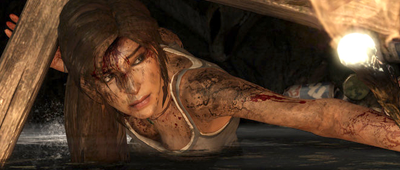
Are the Brutal Tomb Raider Death Scenes Sexist?
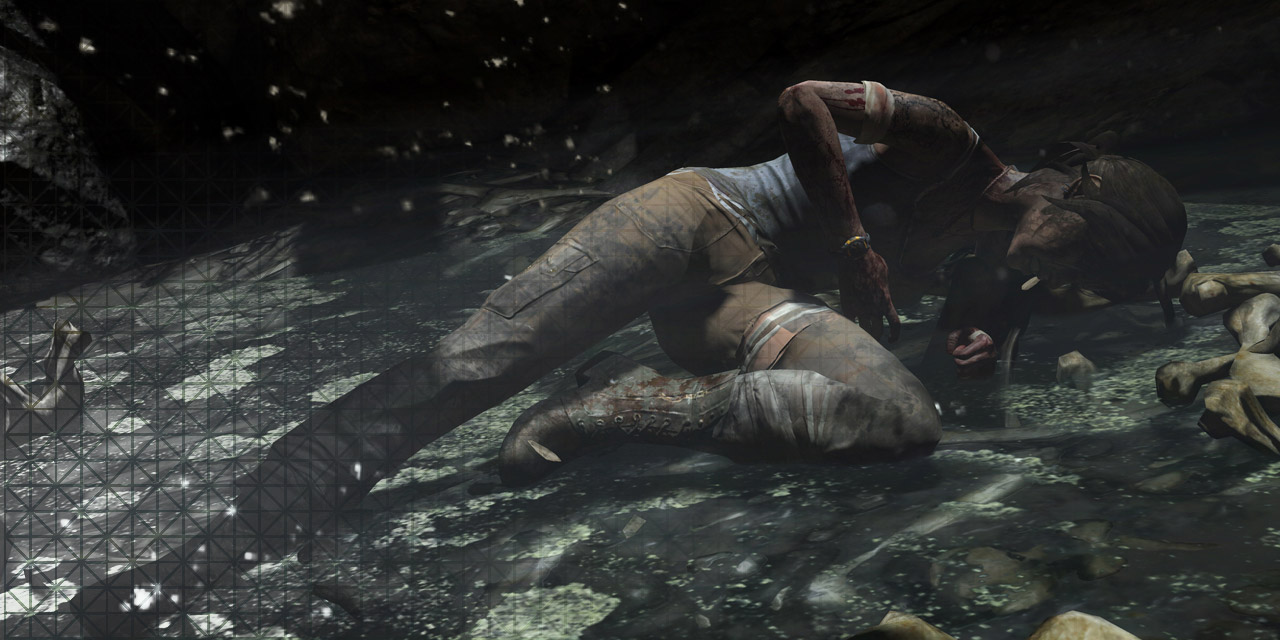
The new Tomb Raider is a reboot to a well-known and beloved series, enlightening us with the backstory to how Lara Croft came to be so skilled at what she does. From the minute Tomb Raider appeared on your television screen, she was shooting wolves in the face and managing to scale rocks and walls unclimbable to the normal NPC. Seeing how Lara came to be “that type of Croft” is the core of this Tomb Raider, and it seems to be hitting its mark considering all the praise it’s received and the big financial success it’s enjoyed.
Despite the rocky start, advocates for the game claim that this Tomb Raider is more mature than its predecessors, while still not losing the fun fans enjoyed of the original. But one thing that’s caught the gaming community’s eye is the absolutely brutal and gut-wrenching death scenes Lara is subject to in the game.
Should you fail to push a button at the right moment during a quick time event, or you just weren’t shaking that analog stick quickly enough, you witness a horrifying end to the 21-year-old’s life, time and time again. These scenes have populated YouTube and Tumblr with videos and gifs alike, as they are definitely something to cringe at, something Conan O’Brian will agree with.
Given the nature of these deaths, and Tomb Raider‘s history, one has to wonder: are these death depictions actually in themselves sexist? Despite critics praising Crystal Dynamics for bringing more personality to Lara’s character, it may seem like the developers found a way to bypass just blatanly sexing her up in shorts by having most of her deaths ending in penetration (dare I say almost phallic-like in nature?).
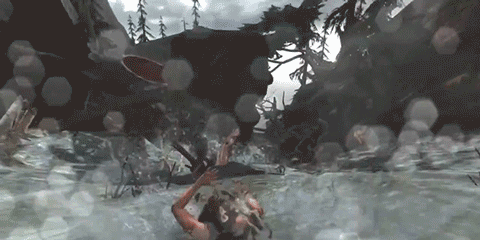
Right from the start, that is after you’re treated to a top view of her falling into the sea, you witness Lara dangling upside down from the ceiling. In her attempt to break free she ends up impaling herself on a sharp stick. While trying to find an exit, if you fail to get away from a grizzly looking man, he stabs Lara in the abdomen with a bony axe. Later on should you get caught by some men that have tied Lara and her colleagues up, she’s penetrated by several arrows.
A few minutes after, Lara can be chocked to death by a man seemingly making advances on her beforehand (maybe fulfilling some form of erotic asphyxiation?). Then of course there’s the infamous stabbed in the throat by a sharp stick while falling down a mountain, which happens yet again when in a river. Even more impaling occurs afterwards, this time when parachuting through trees and failing to navigate correctly to avoid a branch that strikes you in the abdomen.
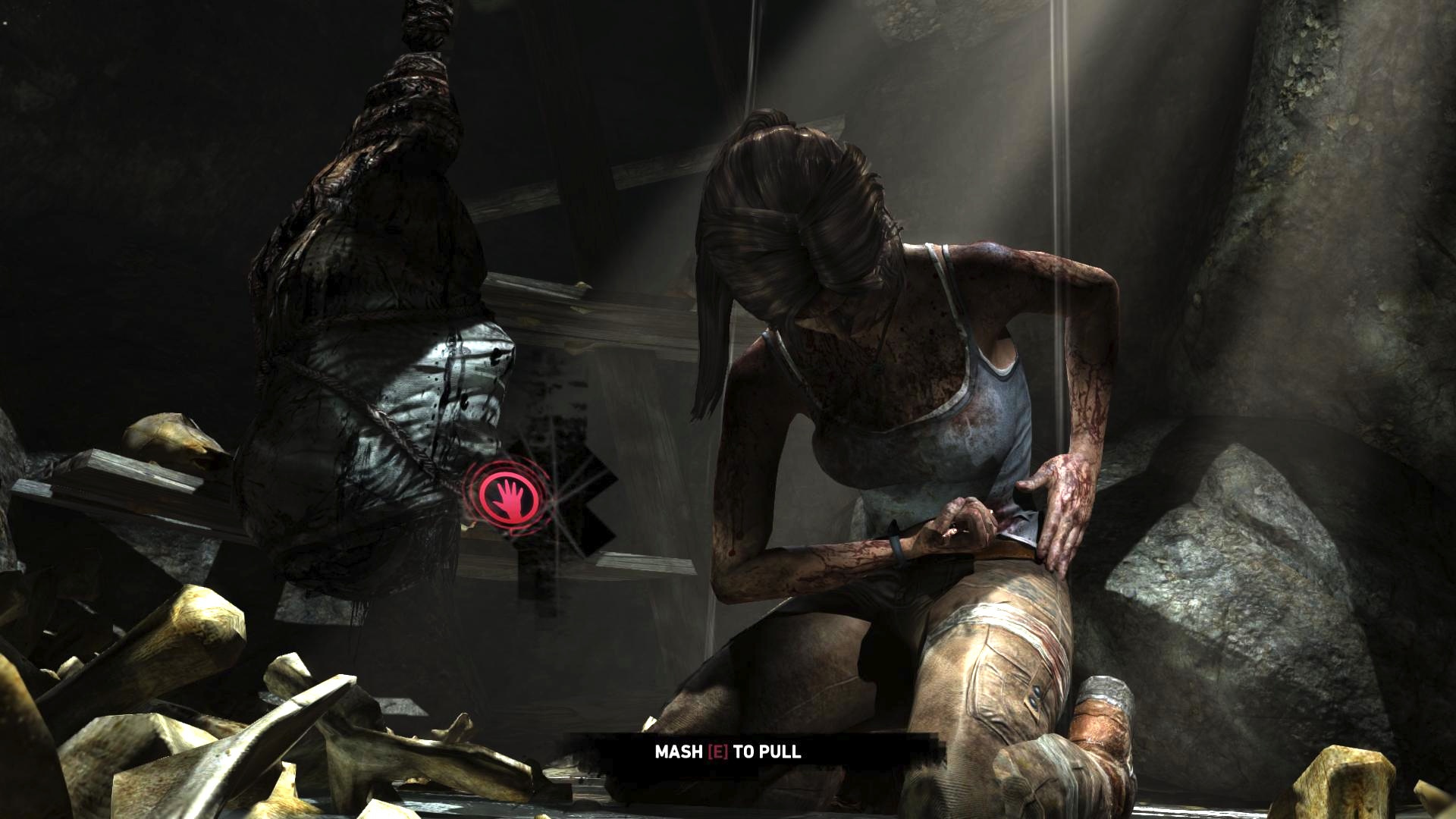
So… are these death scene depictions phallic-like, therefore sexist?
Of course not.
https://www.youtube.com/watch?v=q9BmH7mHFqs
Lara has always been subjected to some morbid deaths, being ripped apart by a shark and falling on spikes comes to mind. Now they’re just in stunning HD and more detailed. If there are no complaints when these type of fail death sequences occur to male protagonists, the scenes in the new Tomb Raider should be acceptable too. Granted even I’m disturbed by these depictions, but not because they’re in any way sexist, they’re just simply a horrible way to go.
I’ve seen some complaints surface on how this is too much gruesomeness for a Lara Croft game, to which I say that’s as silly as I tried to make this post sound. We all know Lara grows up to be an adventurer, even if she fell into her first dangerous voyage inadvertently, and this (unfortunately) comes with the territory. Survival in the wilderness is no easy task, and mixing that with strange individuals who persist on hunting you down will obviously make matters worse. The scenes are in fact necessary to portray just how perilous her journey is, and her sex does not downplay the seriousness of the situation. Furthermore, the deaths in no way glorify violence. The developers worked hard to make these scenes as uncomfortable to watch as it must be for Lara to experience.
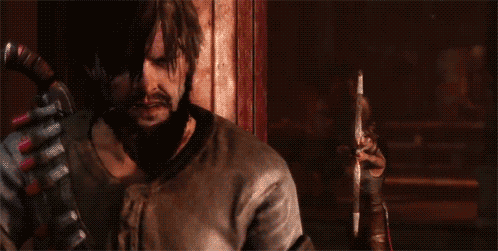
Though Lara’s past will still serve as an example on the exploitation of feminine looks in exchange for male attention in video games, accidental or otherwise, at least this iteration treats Lara more for what she is: an action hero (well, her transformation into one), not a female action hero. This means taking the same risks male heroes take, with the same dire consequences. Once named by Time Magazine as video games’ first sex symbol, Lara is moving forward to be treated mainly on the merits of her adventures.
Thanks for indulging my hidden rant, hope you enjoyed it 😉
Read More
-

Extra Life Spotlight
What is Extra Life?
Extra Life is an annual 24-hour gaming marathon that helps raise money for children hospitals all over the world (through the Children’s Miracle Network). It started as a small drive on Sarcastic Gamer to help a young girl named Victoria (Tori) get through her hospital days as she battled acute lymphoblastic leukemia. When she passed away in 2008, the founder Jeromy Adams honored her life by trying to save others like her. Six years later, Extra Life is still going strong; the charity has managed to raise over $8 million for sick kids–and $4 million of that was just in 2013!
How does it work?
You create an account on extra-life.org, then start asking people to sponsor you for the full 24-hours you’re going to be playing video games. You ask for $1 per hour, which totals to $24, but any amount of money is accepted. The website is easy to use for both donators and the participant, and all contributions are tax deductible! Then on the specified date (displayed on the website), you just play games at your house for 24 hours straight. Thousands of other gamers will be doing the same thing, giving you an opportunity to find new friends that are supporting the same cause!
How are you involved?
I first heard about the charity when I was an editor at Sarcastic Gamer, and have been a loyal contributor since. I helped with the PAXtra Life parties that were held in Seattle in 2010 and 2011 to help raise funds and awareness. Independently I raised over $1,500 in 2010, $1,613 in 2011, and $1,086 in 2012 (I even have a shiny gold medal to prove it).
All my donations have benefited the Miami Children’s Hospital. As an extra avenue, I was able to involve Machinima in the charity in 2012, and we raised $2,558 for the Los Angeles Children’s Hospital.
How can I get involved?
The 24-hour charity usually takes place in the fall, but you can sign up at extra-life.org anytime and start asking for donations! It’s never too early or too late to start helping kids, and what better way than by playing video games?

Past Promotion
- [2011] Epic Games: Extra Life 24-Hour Gaming Marathon October 15th
- [2011] PTFGN: Extra-Life, Where Gamers Can Save Lives
- [2012] Machinima: Extra Life Charity, 24-hour Livestream
- [2012] Machinima: Extra Life PSA with Michael Mando (Vaas)
-

OUYA, an Interesting Time in Gaming History
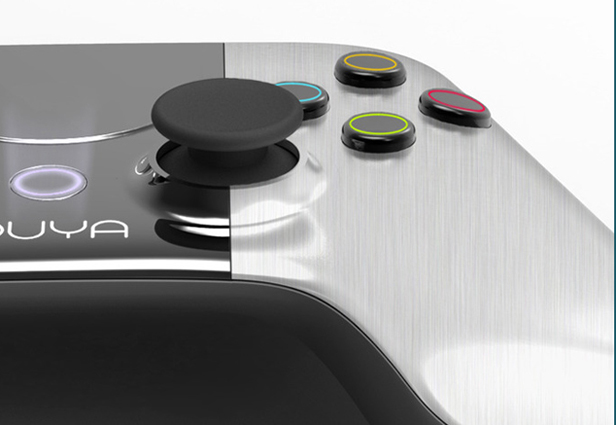
We’re truly experiencing a unique change in gaming history. No, I’m not referring to graphical leaps or better hardware. I’m speaking of the new prospects developers now have where they can easily receive help from the community to make their ideas come to fruition. A time in history where the lines between developer, publisher and retailer are thinning, and the fields of creativity are now accessible on a larger scale.At first I was very skeptical of the website Kickstarter, given it’s lack of accountability if someone were to not deliver on their promises (it’s already happening!), and some developers’ limited understanding of budgets. Though, that isn’t to say that there isn’t some good that can come out of the endeavors, and that’s what we’re seeing with the OUYA.
Read More -
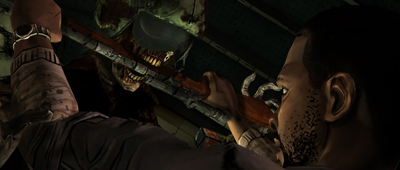
The Walking Dead: Episode 2 Review
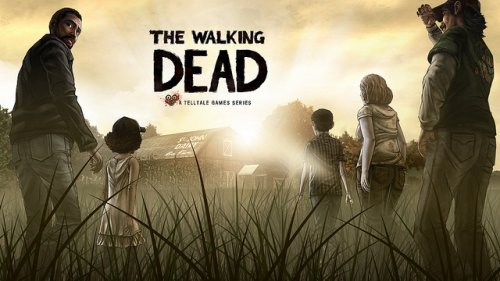
The Walking Dead series has proven to be a monumental hit, evolving well beyond its initial run as a monthly comic book. Having its own board game and expanding into a T.V. series now running into its third season, it was only natural that it take the next step in entertainment by becoming a video game.
Video game adaptions of popular franchises happen all the time, but TellTale Games’ The Walking Dead episodic saga has proven to stand above the rest in terms of story and overall quality. Episode 1: A New Day was not just another attempt at milking money from the fans, it actually stood toe-to-undead toe with some of the narratives from AAA titles out there. Episode 2: Starved for Help is no exception.
Read More -

Kickstarter: Esme’s Gaming Rig

Hey guys! Like I mentioned on Twitter, I want a gaming rig and I decided to start a Kickstarter to raise the money for it. Click below for more details and the link to the Kickstarter!
Read More







